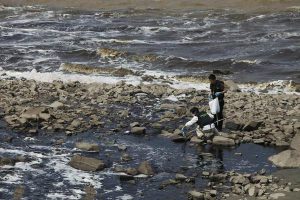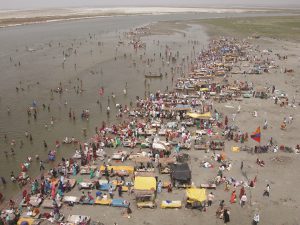Last month, China’s rulers issued the Integrated Reform Plan for Promoting Ecological Civilization, a grandly-named plan for sweeping reforms on how China uses natural resources and can prevent pollution. An excellent English translation was made public on the same day, and the publication coincided with President Xi Jinping’s visit to the US and the UN headquarters in New York that week.
First of all, the plan is very comprehensive and ambitious. It’s also noteworthy that it was issued by the highest levels of both government and the party (The State Council and the Central Committee), signifying that it must be recognised and implemented by both. The plan starts by laying down several key ideas and principles, and then describes eight ‘systems’ which must be established by 2020.
Overall, the plan is very good news for environmental protection and restoration. It picks up on many aspects which will benefit from the proposed reforms.
The document introduces some very important institutional changes, which clearly separate property rights, regulations on how natural resources are used, and responsibility for environmental protection in the following areas:
Property rights: A new government body will be responsible for the ownership of all natural resources. This department may be based on the current Ministry of Land Resources (MLR), but much more comprehensive.
Regulating the use of natural resources: Another single government department will be responsible for “all use-related regulatory duties and responsibilities for all territorial spaces”. This may be a new department, fashioned in a similar style to the State-Owned Assets Supervision and Administration Commission (SASAC). This should help to reduce conflicts and ambiguity between responsibilities of different departments. For example, management of a river in China is currently spread across the Ministry of Water and Resources (MWR) for water allocation, Ministry of Environmental Protection (MEP) for water quality, Ministry of Housing and Urban-Rural Development (MOHURD) for wastewater treatment, and Ministry of Agriculture (MoA) for agricultural runoff.
Environmental protection: “Duties and responsibilities for environmental protection, which are currently spread across departments, will be assigned to one single department”.This would clearly expand the remit of the MEP, where environmental protection functions from other departments are moved to the environment ministry's control.
These reforms are very important because in the past, a lot of environmental problems were allowed to continue because it was not clear who should take responsibility for natural resources. These resources were officially the property of ‘the people’. The latest reform plan was supplemented by a measure which holds government and party officials accountable for environmental damages.
Integrated plans: Municipal and county-level governments must combine different kinds of plans into a single spatial plan – or blueprint – which should cover urban, industrial, rural and protected areas. This is important because in the past, every time a new leader took up office, many old plans would be completely redone, leading to great inefficiency and waste and a short-term mentality.
Importantly, public participation in the process of urban planning is strongly emphasised. In making the spatial plan, the overall environmental impact of all activities must first be assessed to ensure that the population, industrial structure, and economic growth do not surpass the environmental capacity. Also, comments must be sought from relevant sectors and local residents, and finally approved by the local people’s congress. This level of detail is unusual for such a ‘reform plan’, signifying that this emphasis on public participation is to be taken seriously.
In addition, some very important decisions, or hints at proposed new directions, are tucked away in the main text. For example:
Subsidies for all fossil fuels will be phased out: which would be an excellent example for the world, which currently spends US$5 trillion, or 6.5% of global GDP, every year on such subsidies for polluting fuels.
Supervisory role for civil society and the public: The principles mention that “social organizations and the general public should participate and play a supervising role in ecological conservation”. Unfortunately, the detailed paragraphs are less explicit about this role, but it is assumed that the more progressive departments and local governments will apply this principle more than some others.
International cooperation and local-level pilot initiatives: The plan recognises that China should “deepen exchange and practical cooperation with other countries, borrow from their advanced technology and their valuable experience”. It also mentions that local governments are encouraged to start pilot initiatives to proactively explore and move forward with the reform to promote ecological civilization.
System for controlling total carbon emissions: The plan mentions that “a system for controlling total national carbon emissions … will be gradually established”. My reading is that we should expect China to adopt absolute carbon emission targets in the mid-term. The plan also mentions the national carbon emissions trading scheme, as well as trading mechanisms for other pollutants and even energy-use rights.
The plan introduces many other important reforms.They include:
– Improving the pollutant emissions permit system;
– Government procuring services to assist in the management of environmental protection;
– Progressive water pricing for non-household water consumption, and tiered pricing for urban household consumption;
– Mandatory environmental information disclosure for listed companies; and
– Establishing a new national supervision and inspection system for environmental performance of government officials.
Some parts of the plan are not so explicit and would benefit from further clarification by implementing departments. For example, the need for environmental information disclosure is mentioned very clearly, but there is nothing about who should supervise this, nor whether the failure to disclosure information should be punishable or subject to be challenged in court.
Similarly, the eight ‘systems’, including environmental governance, contain little mention of the role of civil society organisations. Also, there is not much mention of access to justice for the public or civil society.
Implementation
The document specifies that the eight ‘systems’ should be established by 2020. All relevant departments as well as local governments are required to draw up plans for the operation of the plan. Ecological civilisation was prepared by around 12 relevant government departments, under the coordination of NDRC, so the final result is probably a compromise. Some departments, such as the Ministry of Environmental Protection, are more likely implement it more pro-actively than others.
In all, it’s an amazing document, especially considering the top level at which it was issued. As with all these edicts from central government, we will have to see how effectively it will be implemented. But since the reforms are quite specific and have deadlines, it is likely to be the framework for China’s ecological efforts in the coming years.






![Dal Lake, Half of Kashmi's wetlands have disappeared in the last century [mage by Athar Parvaiz]](https://dialogue.earth/content/uploads/2015/10/10-300x225.jpg)
